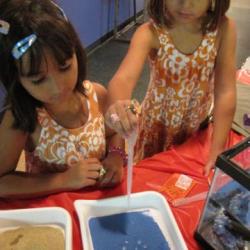Source Institutions
Source Institutions
Add to list Go to activity
Activity link broken? See if it's at the internet archive

In this activity, learners explore how the application of nano-sized particles or coatings can change a bigger material’s properties. Learners investigate the hydrophobic properties of plants, nano-fabric pants and magic sand.
- 5 to 10 minutes
- 10 to 30 minutes
- Over $20 per group of students
- Ages 4 - adult
- Activity, Demonstration
- English
Quick Guide
Materials List (per group of students)
- Assortment of hydrophobic plant leaves, such as lotus leaves, nasturtium leaves, mustard greens, leafy kale, broccoli, or Chinese cabbage and an assortment of non-hydrophobic plants (iceberg lettuce, etc.). At minimum, 4-5 TOTAL leaves (note that more leaves will extend the length of the program)
- Trays for plants
- Beaker of Water
- 1 cup of cocoa mix and spoon or small strainer
- 1 Beaker filled with a purple liquid (water with food coloring will come out in the wash)
- Swatch of non-treated fabric
- Swatch of nano-treated fabric (search online for “stain resistant pants,” then check for the word “nano” in the garment description)
- Miniature Pants made of nanotechnology stain-resistant fabric (search online for “stain resistant pants,” then check for the word “nano” in the garment description)
- Regular-sized nano pants (search online for “stain resistant pants,” then check for the word “nano” in the garment description)
- Water guns filled with purple liquid (to resemble grape juice) - optional
- Tray and hanger for miniature and regular-sized Nano Pants, respectively
- Magic Sand®
- Regular Sand
- Demo Tank, small aquarium, or large bowl
- 2 small plates (or petri dishes)
- Two cups for magic and regular sand
- Large serving spoon
- 3 Plastic (or stainless steel) spoons
- 6 Multiple Pipettes
- Paper or regular towels
Subjects
-
Engineering and Technology
-
Engineering
- Metallurgy and Materials Engineering
- Nanotechnology
-
Engineering
-
Life Sciences
-
Diversity of Life
- Plants
-
Ecology
- Biodiversity
-
Diversity of Life
-
Mathematics
-
Measurement
- Units of Measurement
- Size and Scale
-
Measurement
-
Physical Sciences
-
Chemistry
- Chemical Bonding
- Chemical Reactions
-
Structure and Properties of Matter
- Atomic Structure
-
Chemistry
-
The Nature of Science
-
The Scientific Process
- Conducting Investigations
-
The Scientific Process
-
The Nature of Technology
-
Technology and Society
- Impacts of Technology
-
Technology and Society
Informal Categories
- Nature and Environment
Audience
To use this activity, learners need to:
- see
- see color
- touch
Learning styles supported:
- Involves hands-on or lab activities
Other
Components that are part of this resource:
This resource is part of:
Access Rights:
- Free access
By:
Rights:
Funding Sources:
- National Science Foundation, 0532536
- National Science Foundation, 0940143
